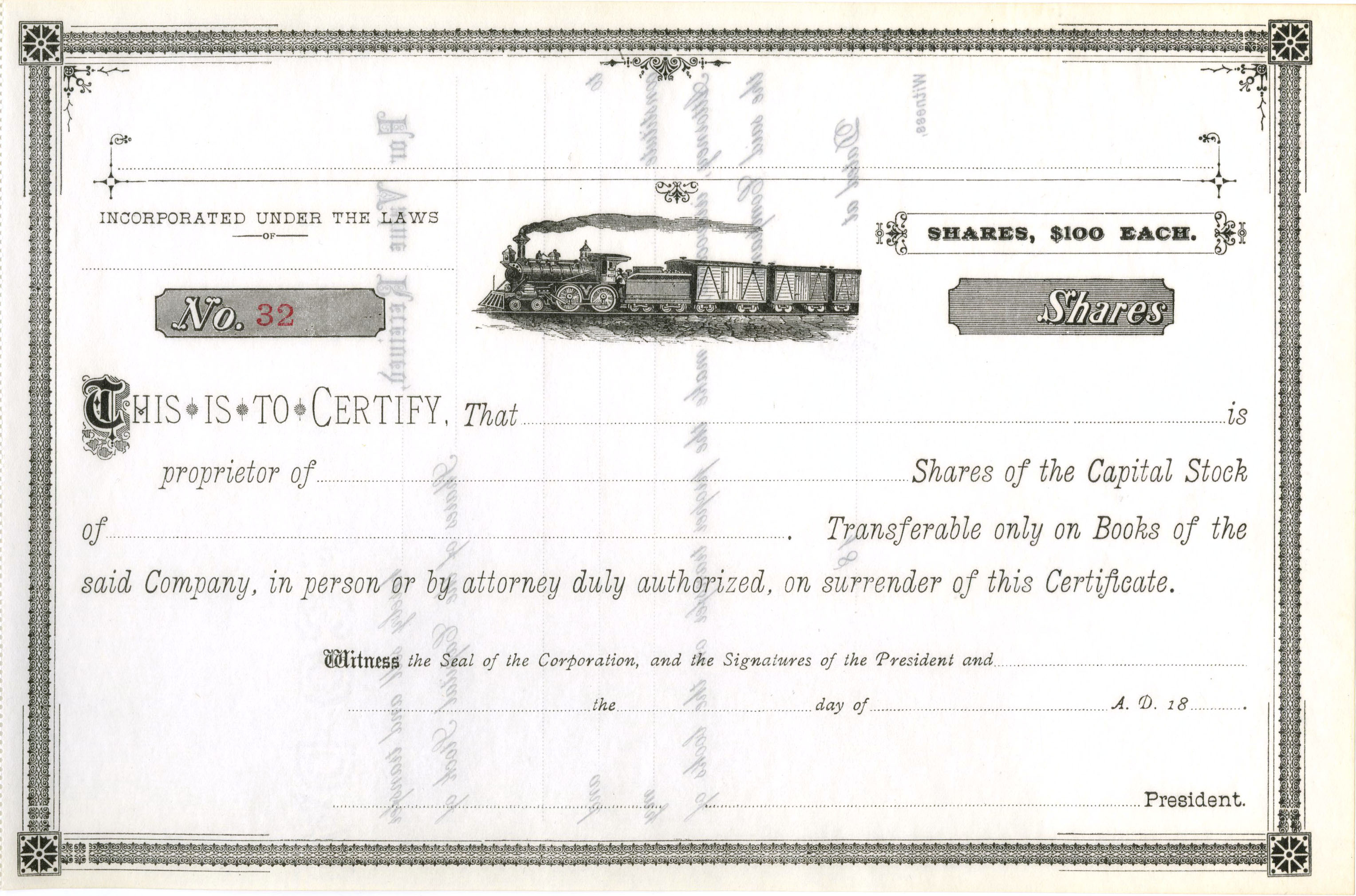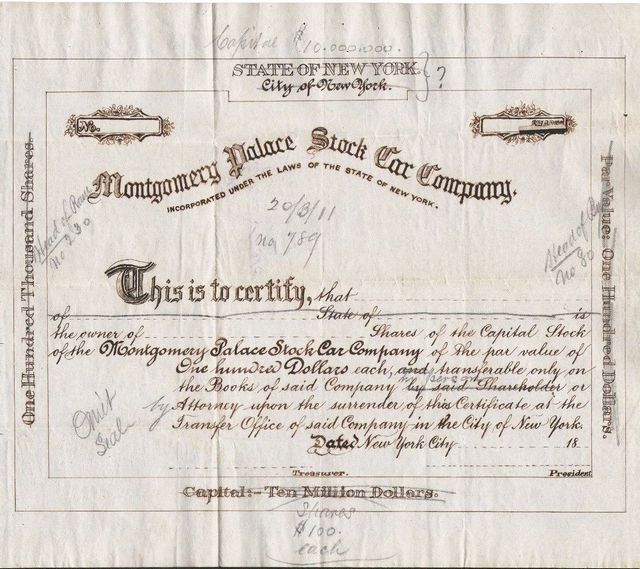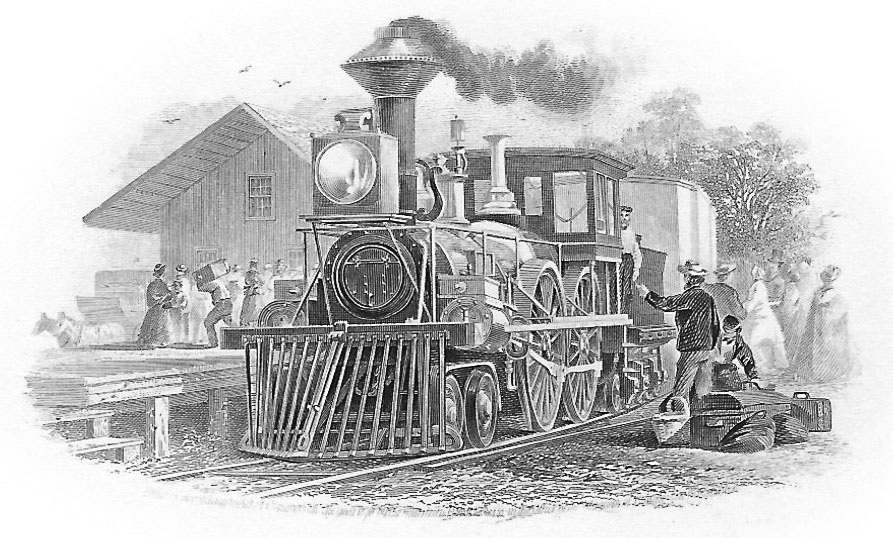Creating documents to be used as securities and related purposes
What certificates were needed and at what cost?
The real first step, of course, was for a company to determine what kind of document was needed and at what time – stock certificate, bond certificate, or some other kind of limited purpose document. The next step was a decision about how much to spend on that process.
If the company were a raw startup, intent on laying rail into new territory, a company might have decided it was wise to "test the waters" before spending a lot of money. Were there going to be sufficient numbers of investors who willing to risk sufficient money to get a company off the ground? Companies often experimented by trying to find investors willing to "subscribe" to a new stock issue by putting ten percent down in return for a locally-printed "subscription receipt."
The example at right is a generic stock certificate used by companies with little to spend on promotion. It displays a stock train vignette and a pre-printed $100 par notice. Every other feature was meant to be filled in by hand
When founders had enough money and needed to impress wealthy contacts, some paid a professional engraving company to create a custom title and use one or more stock vignettes to create a new stock certificate. Companies with less robust treasuries might have decided to use pre-printed certificates with generic designs and locally typeset titles.

Established railroad companies might have worried more about their corporate images and contracted with top-tier engraving companies such as American Bank Note Company to design fully-customized certificates for them. There was a wide gulf of possibilities between generic and fully custom-made certificates, both in quality, cost and self-promotional attitudes.
Design
It was costly to contract with companies like Homer Lee, International Bank Note, and American Bank Note for design input. At the other end of the spectrum were second- or third-tier generic certificates that were readily available from stationery sellers. If companies believed "good enough" was good enough, companies could have purchased small numbers of blank certificates and filled in details by hand. The scripophily hobby displays the whole realm of possibilities and plentiful evidence of century-old corporate decisions.
Companies that used generic certificates were commonly small and most seem to have had grandiose plans of success seldom shared by their would-be investors. Surviving certificates suggest many such companies failed to sell more than twenty certificates; some failed before even selling that many.

Although relatively few examples survive, some companies were either desperate or in big hurries and hand-wrote or typed their own stocks certificates. Even a few hand-written bonds survive. These kinds of certificates are highly interesting, but low prices suggest most collectors feel otherwise.
Another approach was to contract with a major engraving/printing house to design certificates. Shown at left is an undated, unattributed mockup of a stock certificate prepared for the Montgomery Palace Stock Car Company, probably in the early 1880s. It appears that the engraving company created a rough mockup and sent it to the car company. Someone there marked it up further and returned it to the engraver for furhter modification. No issued certificates from this company are currently known, so we have no idea what the final product might have looked like or whether any were actually printed and issued. (Image courtesy K. Clifford Priest.)
Markings below the wavy title appear to refer to an existing, numbered vignette. Engraving/printing companies normally retained numerous etched and engraved vignettes of widely different subjects that could be inserted into stock and bond designs as needed. Chances are, the vignette chosen for this certificate would have portrayed cattle, a train, or perhaps a cattle car. It is likely the text would have been engraved into a seperate steel or copper plate.
Execution
American Bank Note Company employed numerous artists and engravers who produced many thousands of vignettes. Some vignettes were created and dedicated for the use of single companies, but the vast majority were stock images that the company compiled in vastly variable combinations. One of the more commonly-used vignettes was this one below named, "Locomotive." At present, this vignette is known to appear on 193 different varieties of stocks and bonds from 94 distinct companies. I suspect the vignette will exceed 200 varieties in a few years. One can only imagine how many obsolete bank notes used this remarkable vignette.
The image was drawn and engraved by renowned artist James David Smillie, and appeared on a banknote as early as 1864. One of the hallmarks of Smillie's art was his impressive penchant for details. Depending on cropping applied during use on various banknotes and securities, one can spot as many as seventeen people on both sides of the train.
Learning more

The database for this project identifies vignettes by name when known. Please see more named vignettes by American Bank Note Company in its six Archive Series released from 1987 to 1992. Readers are also advised to consult The Engraver's Line: An Encyclopedia of Paper Money and Postage Stamp Art by Gene Hessler (BNR Press, 1993) for vastly more information about vignettes and the artists and engravers who created them. I also highly recommend Images of Value: The Artwork Behind U.S. Security Engraving, 1830s–1980s by Mark D. Tomasko, (The Grolier Club, 2017) and The Art of the Market: Two Centuries of American Business as Seen Through Its Certificates by Bob Tamarkin and Les Krantz (Stewart, Tabori & Chang, 1999.)
Finding information about engraving and etching is a bit tricky. There is a good coverage of woodblock engraving in Beyond the Lines: Pictorial Reporting, Everyday Life and the Crisis of Gilded Age America by Joshua Brown (University of California Press, 2002.) Stone lithography is well covered in Satire on Stone: The Political Cartoons of Joseph Keppler by Richard Samuel West (University of Illinois Press, 1988.)